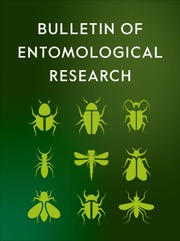No CrossRef data available.
Article contents
Identification and expression analysis of cathepsin B genes in Myzus persicae (Hemiptera: Aphididae) and their response to environmental stresses
Published online by Cambridge University Press: 31 March 2025
Abstract
Cathepsin B (CTSB) is a cysteine protease that is widely found in eukaryotes and plays a role in insect growth, development, digestion, metamorphosis, and immunity. In the present study, we examined the role of CTSB in response to environmental stresses in Myzus persicae Sulzer (Hemiptera: Aphididae). Six MpCTSB genes, namely MpCTSB-N, MpCTSB-16D1, MpCTSB-3098, MpCTSB-10270, MpCTSB-mp2, and MpCTSB-16, were identified and cloned from M. persicae. The putative proteins encoded by these genes contained three conserved active site residues, i.e. Cys, His, and Asn. A phylogenetic tree analysis revealed that the six MpCTSB proteins of M. persicae were highly homologous to other Hemipteran insects. Real-time polymerase chain reaction revealed that the MpCTSB genes were expressed at different stages of M. persicae and highly expressed in winged adults or first-instar nymphs. The expression of nearly all MpCTSB genes was significantly upregulated under different environmental stresses (38°C, 4°C, and ultraviolet-B). This study shows that MpCTSB plays an important role in the growth and development of M. persicae and its resistance to environmental stress.
- Type
- Research Paper
- Information
- Copyright
- © The Author(s), 2025. Published by Cambridge University Press.



